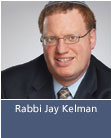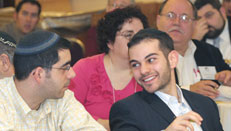 |
||||||||||||
| Weekly Parsha | ||
| Current Week | ||
| Parsha Archives | ||
| Business Ethics | ||
| Dr. Malamet Speaks Out | ||
| TiM MP3 Library | ||




A Thought for the Week with Rabbi Jay Kelman
|
 Judaism measures greatness by spiritual achievements. It should come as no surprise that many of our founding fathers suffered from physical ailments. Yitzchak was blind, Yaakov partially crippled, and Moshe had a speech impediment. Their eminence was such that whatever "handicaps" they might have had were simply irrelevant. Physical limitations are no impediment to greatness. Nonetheless, physical and material attributes are sometimes crucial. Jewish law reflecting the (sad) trait of humans to (only?) respect those who possess material wealth rules that our leaders, the high priest and king, for example, were to be people of great means. Physical deformities disqualify a priest from offering the priestly blessing, as people are wont to focus not on the blessing but on the defect. Thus, in a society where people are (thankfully) more accepting of physical handicaps, a kohen suffering from certain handicaps would be allowed to join in blessing the people. The Torah insists that those who work in the Temple be free of physical blemish. More conspicuously, only those of priestly descent could perform Temple duties. While in our egalitarian times this may seem unfair, Judaism has never equated equality with sameness. The 248 positive mitzvoth, which our Sages say correspond to the limbs in our body, reflect this notion of teamwork, with each person doing their part. While each part of the body is interconnected, each has its own specific role to play. The 613 mitzvoth reflect this harmonious union of diverse roles. No one person can even come close to performing all the mitzvoth, as some pertain specifically to women and some to men, some to children, some to nations, some to leaders, some to farmers, some to homeowners-the list goes on and on. It is the Jewish people as a whole, and only as a whole, who can observe all 613 mitzvoth. The Temple service was limited to the very few; possibly because, in the grand scheme of things, it actually was not so important. The Temple is a reflection of our relationship to G-d, a tangible symbol of the Jewish people living up to their mission. That relationship is built outside the Temple in our day-to-day lives. The kohanim themselves only worked two or three days a year in the Temple ; the rest of their time was spent as civil servants, as teachers of Torah amongst the people. Of course, as much of the work in the temple was physically challenging-for example, the kohanim had to do their work while standing, and breaks were few and far between-it is not surprising that the retirement age was 50. The Temple marks the unity of the physical and spiritual worlds, where one uses physical means to attain spiritual heights. The 39 melachot prohibited on Shabbat are derived from the Temple service; physical creation is defined by its spiritual usefulness. We should thus view the physical impediments to Temple service from a spiritual perspective. "Any man on whom there is a bodily blemish may not approach to present an offering of his G-d.a blind man, or lame, or who has a deformed nose or a misshapen limb" (21:17-18). The Torah tell us that among those unable to work in the Temple is one whose limbs are disproportionate; for example, one eye is much larger than the other. Rav Nisson Alpert was reported to have said, in describing the greatness of his Rebbe, Rav Moshe Feinstein, that these disproportionate limbs allude to those whose spiritual growth is uneven and inconsistent. Rav Moshe, zt"l, epitomized one who was great in all areas of life. While it is to be expected that one specialize in certain areas in terms of learning and even observance, it is a "blemish that disqualifies" when the proportions are well off balance. When one becomes more and more meticulous in ritual observance without any increase in observance in relationships to other people; when one observes every stringency in regard to kashrut, but relies on every leniency in business ethics; when one's focus on the land of Israel blinds one to the needs of the people of Israel-or vice versa on any of the above-that person is leading a blemished Jewish life. At times, such blemishes can be a desecration of G-d's name; the mitzvah not to desecrate G-d's name appears just a few verses later. The Talmud (see Yoma 86a) seems to imply that one who is neglectful in the area of interpersonal relations actually should not observe the rituals of Judaism. We must broaden our religious growth, even if it means slowing our climb. We must look to widen before we look higher. In order to serve in G-d's temple, the temple that dwells within each of us, let us strive to lead a balanced life, with each aspect of our spirituality moving in the same direction.
|
|
|

 |
 |